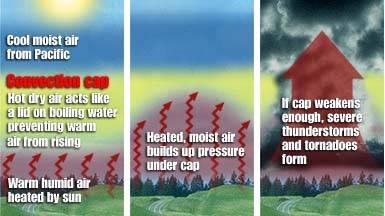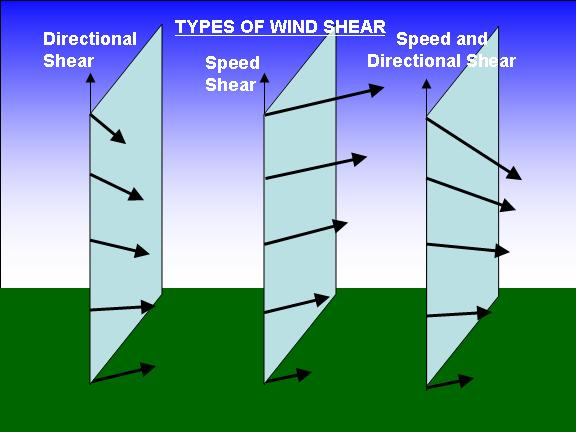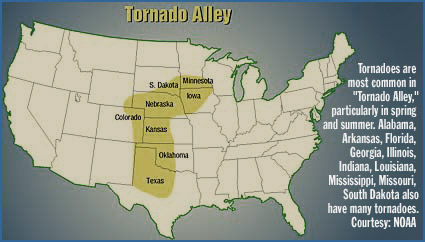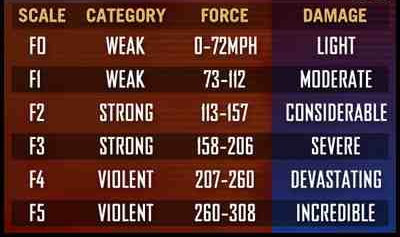|
Tornado Definition
>> A violently rotating column of air
that touches the ground
>> Tornadoes usually form within supercell thunderstorms
Supercell Thunderstorms
>> The most intense type of
thunderstorm
>> Ingredients needed to form a supercell thunderstorm
Several ingredients are required
to form a supercell thunderstorm. The first is a trigger to get the air to rise. Most often the
trigger is upper-level divergence on the east side of a trough. In addition to this rising air, however, a layer of warmer air
above the surface called a capping inversion is usually present. This
capping inversion gives the storm its intensity because it allows
energy to be trapped beneath the inversion, or lid, until the lid breaks.
Once the lid breaks, the thunderstorm develops in an explosive manner.
This capping inversion can be broken in one of two ways - either through the
heating of the layer below the lid or through the use of a lifting mechanism
which will cool the dry air faster and cause destabilization. A simple
diagram explaining a capping inversion is shown below in Figure 1.
|
 |
|
Figure 1:
The image above illustrates the role of a capping inversion in supercell
thunderstorm and tornado formation. |
Finally, a large amount of vertical
wind shear is important in order to form and maintain the structure of a
supercell thunderstorm. This extreme wind shear allows for the updraft to
be tilted and separated from the downdraft. This allows the thunderstorm
to be long-lived and powerful. A diagram illustrating the various types of
wind shear can be seen in Figure 2 below.
|
 |
|
Figure 2:
The image above shows the different types of wind shear that are present in
the atmosphere. Both directional and speed shear are important in
supercell and tornado formation. |
>> Not all supercell thunderstorms
give rise to tornadoes
Vertical Wind Speed Shear
>> Last ingredient needed for tornado
development
>> Vertical wind speed shear results in horizontal rotation
>> Horizontal rotation is lifted into the updraft and becomes a rather wide
vertical column of slowly rotating air
>> Pressure in the center of the thunderstorm drops due to latent heat release
This pressure drop in the center of
the thunderstorm leads to greater convergence. This convergence allows the
slowly rotating column of air to contract and slowly stretch toward the surface.
As the rotating column of air is stretched and contracted, the rotation rate of
the column increases due to the conservation of angular momentum. The
result is the violently swirling column of air known as a tornado.
Rear Flank Downdraft
Downward moving air on back side of
storm, often a good predictor of tornadogenesis. Increased wind shear and vorticity?
Tornado Climatology
>> Most violent and most frequent in
the southern Great Plains/"Tornado Alley"
|
 |
|
Figure 3:
Tornado Alley is highlighted in yellow above. This area of the country
experiences more violent tornadoes than any other place on earth. |
Tornadoes are most frequent throughout
the southern Great Plains, also known as "Tornado Alley". This is largely
because in this region of the country, warm, dry air from the
Mexican Plateau often overlies the warm, moist air from the Gulf of Mexico.
This allows an almost constant capping inversion to be present through this area
of the United States. A map depicting the area known as "Tornado Alley"
can be seen in Figure 3 to the right.
Tornado Intensity: Fujita Scale
>> Ranges from F0 (weak) to F5
(strong)
|
 |
|
Figure 4:
The table above shows the categories of Fujita Scale of tornado intensity. |
The Fujita Scale of tornado intensity
ranges from F0 (weak tornado) to F5 (strong tornado). A table describing
each category can be seen in Figure 4.
>> Intensity based on damage survey
Enhanced Fujita Scale
The Fujita Scale intensity is based on
damage surveys taken by the National Weather Service. Tornado intensity
cannot be determined directly through the use of wind measuring instruments as
none have ever survived the fury of a tornado. It is also very hard to
place special instrumentation that could survive a tornado in the direct path of
an oncoming funnel.
Suction Vortices
>> Storm velocity + Tornado rotation
velocity + Suction vortex rotation velocity
>> Can yield incredible damage
|